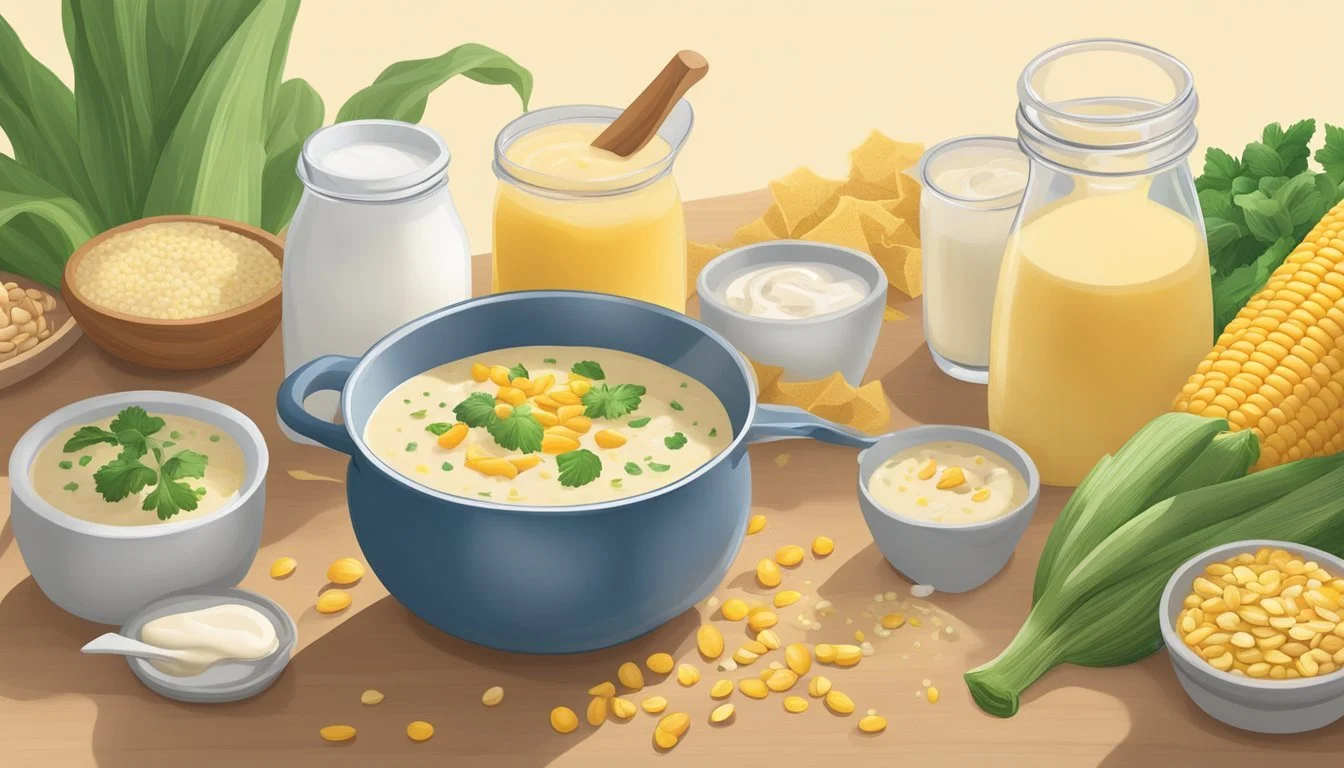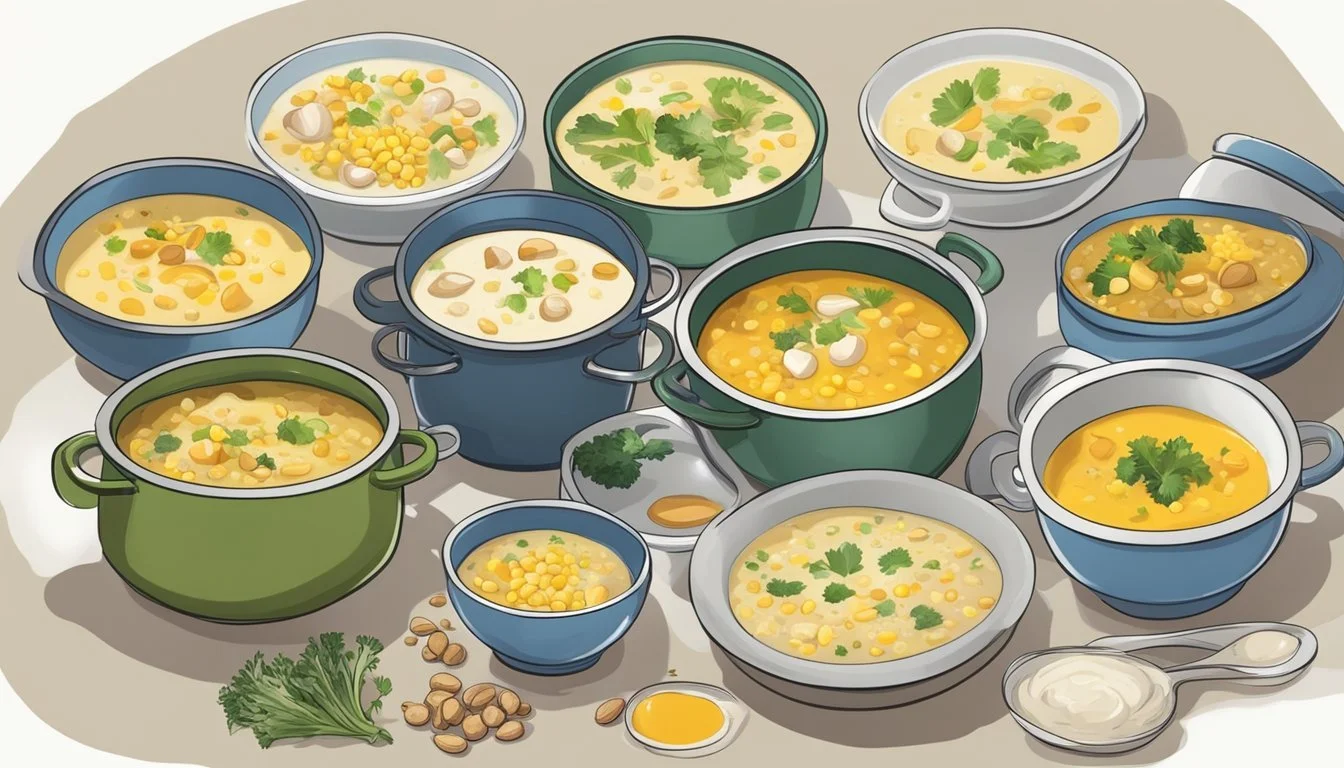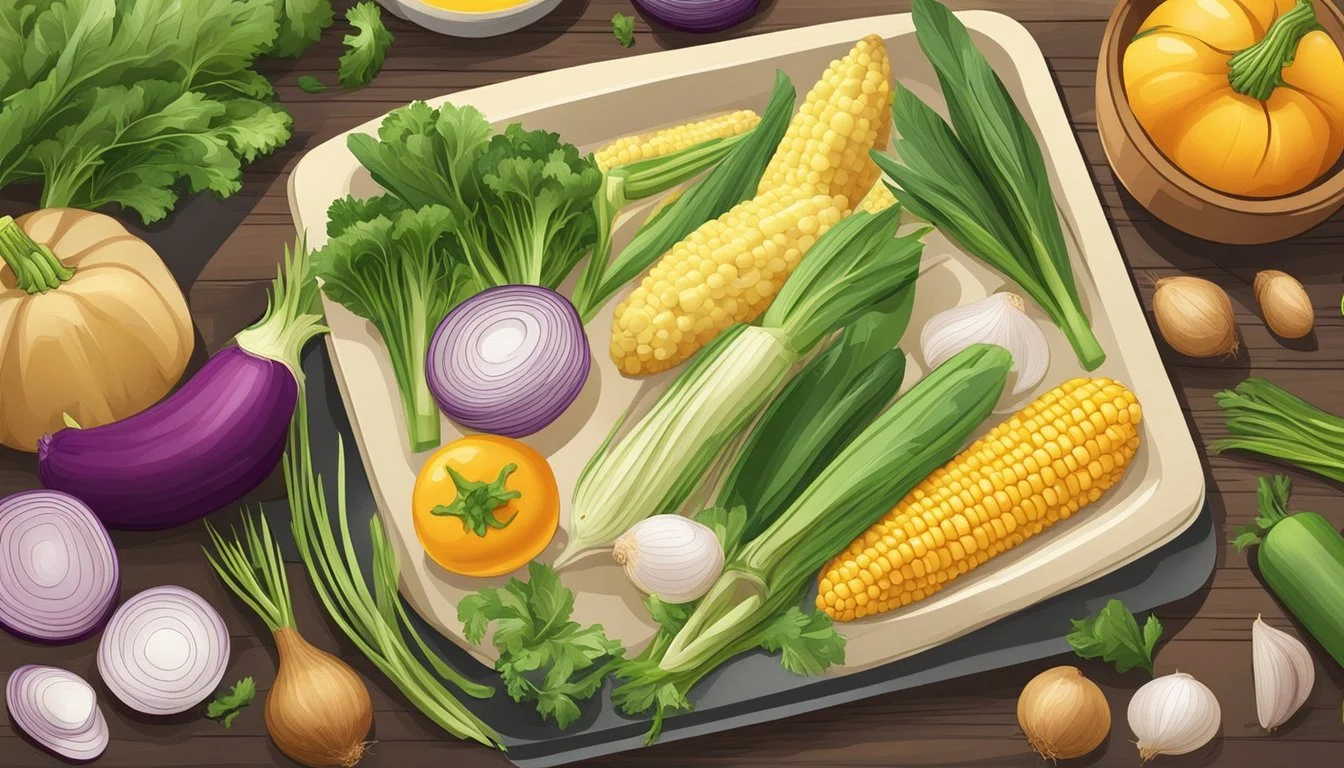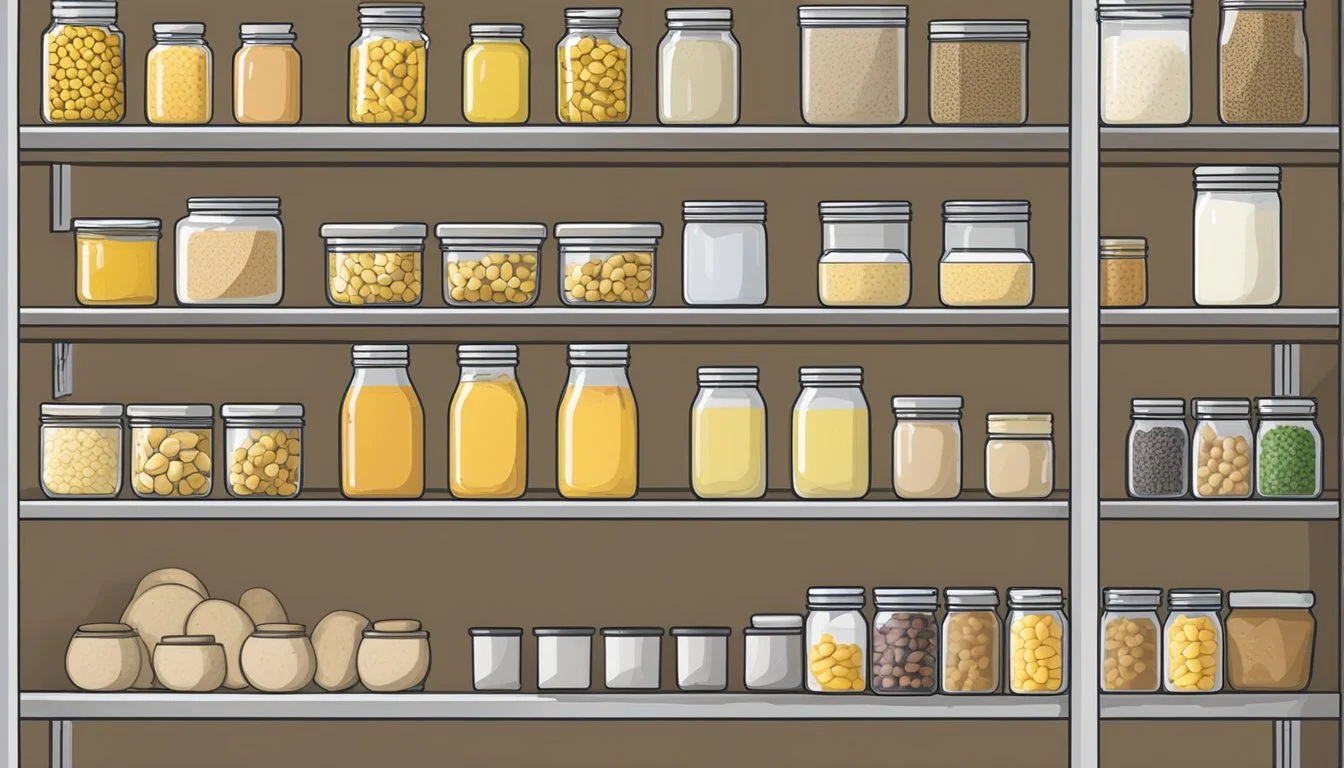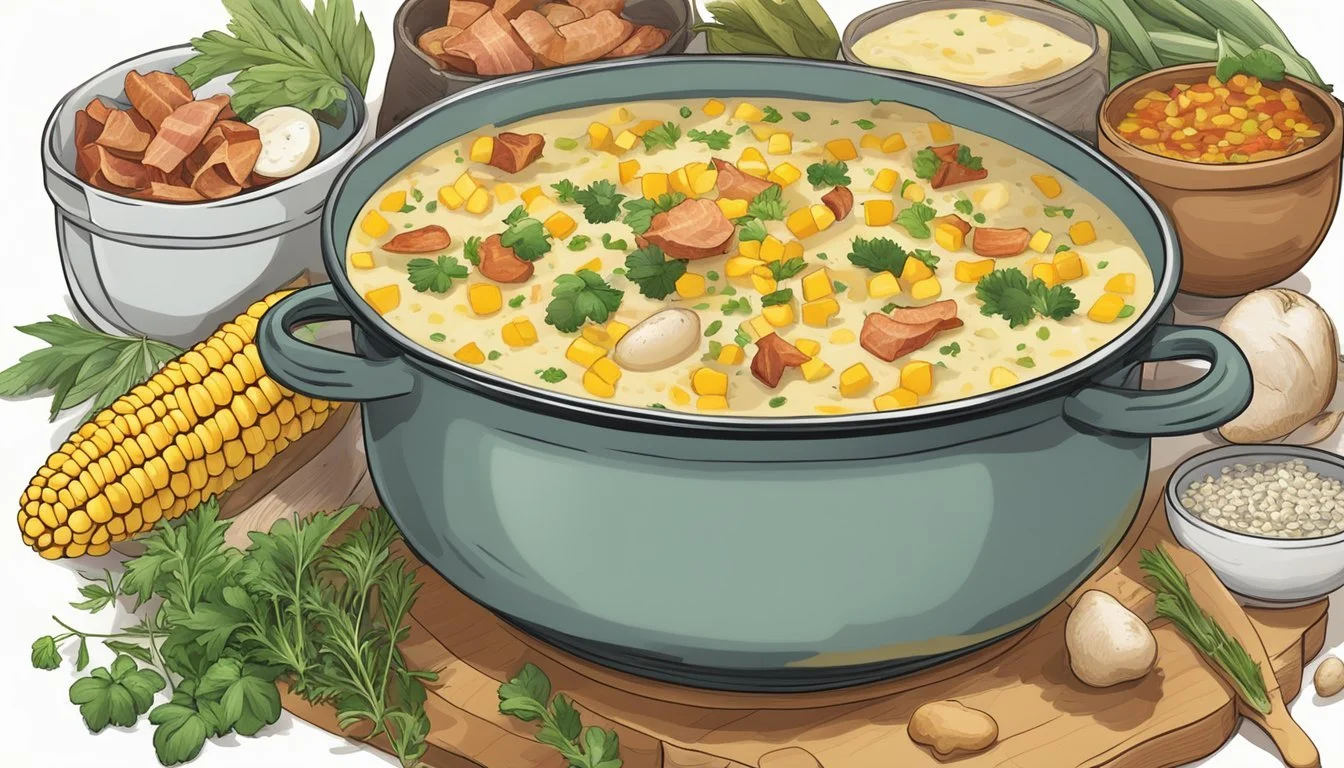Corn Chowder Substitutes
Delicious Alternatives for Every Diet
For those days when you're craving a hearty bowl of corn chowder but can't find fresh corn, don't worry. There are several excellent substitutes that can maintain the creamy texture and rich flavor you love. Broccoli, cauliflower, zucchini, and potatoes are some of the best alternatives to corn in chowder recipes.
Each substitute offers its unique taste and nutritional benefits, ensuring your chowder remains delicious and satisfying. Broccoli and cauliflower add a slightly earthy flavor, while zucchini brings a mild sweetness similar to corn. Potatoes provide that classic, comforting consistency and blend into the chowder seamlessly when pureed.
Experimenting with these substitutes can lead to new and delightful variations of your favorite dish. Whether you're avoiding corn due to dietary restrictions or simply looking to try something different, these alternatives will help you create a chowder that's both familiar and refreshingly different.
Understanding Corn Chowder
Corn chowder is a hearty and creamy soup, often featured in recipes for its rich texture and unique flavor profile. Key ingredients and preparation methods contribute significantly to its signature characteristics.
Basic Ingredients
Corn chowder primarily uses corn as the star ingredient, often enhanced with potatoes for added body and creaminess. Onions, celery, and garlic provide a flavor base, while broth or stock is used as the liquid foundation.
Dairy components, such as milk or cream, are essential for achieving the classic creamy texture. Some recipes also incorporate bacon or ham for a smoky, savory depth. Herbs and spices, including thyme, bay leaf, and black pepper, round out the flavor.
Corn Chowder Texture and Flavor Profile
The texture of corn chowder is notably creamy and thick. This is often achieved through the use of potatoes and dairy, which create a velvety consistency. Some recipes may include a portion of the chowder being pureed to enhance this smooth texture.
The flavor profile is a balance of sweet from the corn, savory from the broth and onions, and occasionally smoky if bacon or ham is included. Herbs like thyme add aromatic qualities, while black pepper provides a subtle heat.
Corn chowder, with its comforting and rich attributes, remains a favorite particularly in cooler weather, offering warmth and sustenance in every spoonful.
Corn Substitutes in Chowder
Choosing the right substitutes for corn in chowder ensures the dish retains its hearty texture and rich flavor. Below are the best alternatives to fresh sweet corn, suitable for any chowder recipe.
Understanding Corn Alternatives
Corn adds sweetness and crunch to chowder. When looking for substitutes, it's essential to find ingredients that can replicate these qualities. Fresh or frozen corn can usually be replaced by vegetables or grains that have a similar bite and moisture content.
Vegetable Substitutes
Several vegetables can effectively replace corn in chowder. Broccoli offers a similar bite and a slightly sweet flavor. Cauliflower provides a mild taste and can be chopped into small florets to mimic corn kernels. Zucchini, when diced, adds tenderness and a slight sweetness, making it a good substitute.
Potatoes can also replace corn, especially red or new potatoes, which add creaminess. Carrots, when diced, add sweetness and color. Using these vegetables ensures the chowder remains hearty and flavorful.
Grain and Legume Substitutes
Certain grains and legumes can be great alternatives to corn. Quinoa provides a slightly nutty flavor and a chewy texture, similar to corn kernels. Barley can also substitute corn, offering a pleasant chewiness and earthy taste.
Chickpeas or white beans offer a creamy texture and mild flavor, which integrates well into chowder. These legumes make the dish heartier and add protein, making them particularly good for vegan or vegetarian chowders.
Choosing the right corn substitute can significantly impact the final dish. By utilizing vegetables and grains that can replicate the texture and flavor of corn, one can maintain the essence of a traditional chowder without sacrificing quality.
Dairy Substitutes in Corn Chowder
Creating a dairy-free corn chowder involves substituting traditional milk and cream with non-dairy alternatives that provide creaminess and rich texture. Key substitutes include various non-dairy milks and ingredients that mimic the creamy texture of dairy.
Non-Dairy Milks
Non-dairy milks are a staple in vegan and dairy-free corn chowder recipes. Options like almond milk, soy milk, and coconut milk are popular choices. Almond milk offers a mild flavor that blends well without overpowering the chowder. Soy milk provides a thicker consistency, making it a good choice for a creamier soup.
Coconut milk is another excellent option, particularly for those who enjoy a slight coconut flavor in their chowder. It adds a rich, creamy texture, making the chowder indulgent without the need for dairy. Oat milk and cashew milk can also be used, offering subtle flavors and smooth textures.
Creamy Texture Alternatives
To achieve a creamy texture without dairy, several alternatives can be employed. Blended vegetables like potatoes or cauliflower can be pureed and added to the soup. These vegetables provide thickness and creaminess, enhancing the chowder's consistency.
Using olive oil in combination with flour or cornstarch can mimic the richness of cream. Creating a roux with these ingredients helps to thicken the soup seamlessly. Another method includes using nutritional yeast, which imparts a cheesy flavor while contributing to a creamy consistency.
Additionally, coconut cream can be added for an extra-rich texture, particularly beneficial in vegan corn chowder recipes. This alternative is especially useful for those seeking a thicker, dairy-free chowder with a luxurious mouthfeel.
Soup Base and Broth Variations
Corn chowder offers versatility in its soup base, allowing for both vegetable-based and meaty or seafood broth options. These variations cater to different dietary preferences and add unique flavors to the chowder.
Vegetable-Based Broths
Vegetable broths are ideal for those seeking a plant-based alternative. They provide a light yet flavorful base that complements the corn's sweetness. Common ingredients include carrots, celery, onions, garlic, and herbs like thyme and bay leaves. When preparing, it's important to simmer the vegetables long enough to extract their full flavor.
Vegetable broths make an excellent choice for summer soups, as they tend to be lighter and more refreshing. They are also versatile and can be easily adjusted by adding other vegetables or seasoning to taste. Using nutritional yeast can add a rich, savory depth often missed in vegetarian recipes.
Meaty and Seafood Broth Options
For those not restricted by dietary preferences, meaty and seafood broths provide a rich, hearty base for corn chowder. A chicken or bacon-based broth introduces a smoky, umami flavor, adding depth and complexity to the dish. Similarly, clam broth can turn the chowder into a deliciously savory seaside treat.
These broths are particularly favored in winter soups for their robust characteristics that offer warmth and comfort. When making a meaty broth, simmer bones or meat slowly to extract full flavors. For seafood options, clam juice and fish stock are excellent choices, enhancing the chowder with a distinct seaside essence.
Ultimately, the choice of broth greatly impacts the chowder's flavor profile, catering to different tastes and seasonal desires.
Additional Ingredients for Flavor and Texture
Incorporating a variety of seasonings, herbs, vegetables, and garnishes can greatly enhance the flavor and texture of corn chowder, transforming a simple dish into a memorable experience.
Seasoning and Herbs
Garlic and onion are foundational to many chowders. They add a rich, savory note that complements the sweetness of corn.
Using fresh thyme introduces a subtle, earthy aroma, while salt and pepper are vital for balancing flavors.
Consider employing smoked paprika for a hint of smokiness or a sprinkle of cayenne pepper for some heat.
Jalapeño can also be added for a spicy kick. A dash of olive oil can enhance these seasonings, ensuring they infuse evenly throughout the chowder.
Vegetables and Garnishes
Yukon Gold potatoes are an excellent choice, offering a creamy texture once cooked. Carrots and celery add both flavor and slight crunch, balancing the creaminess.
Red bell peppers can provide a sweet, slightly tangy taste.
For a twist, add leek, which offers an onion-like flavor without overpowering the dish.
Tomatoes, diced finely, can add a touch of acidity and freshness.
Garnishes like fresh parsley or a dollop of sour cream can brighten up the chowder visually and flavor-wise.
For an added layer of flavor, consider sprinkling some cheddar cheese or chopped bacon over the top.
Cooking Techniques
Different cooking methods for corn chowder substitutes cater to various preferences and equipment availability. Whether using traditional stovetops, blenders, or modern appliances like Instant Pots, understanding each method optimizes the cooking experience.
Stovetop Methods
Cooking corn chowder substitutes on the stovetop involves simmering ingredients for optimal flavor. Begin by sautéing aromatic vegetables such as onions, garlic, and celery in butter or oil. This initial step enhances the chowder's foundational flavors.
Afterward, incorporate the primary substitute ingredients, such as potatoes, cauliflower, or carrots, along with broth or milk. Allow the mixture to cook over medium heat for roughly 20-30 minutes until the vegetables soften. Stir occasionally to prevent sticking and ensure even cooking.
For a smoother texture, a portion of the mixture can be mashed using a fork or potato masher.
Blender and Immersion Blender Use
Blenders and immersion blenders are useful for achieving a creamy consistency. After the initial stovetop cooking, a standard blender can be used to puree the chowder in batches. Transfer small amounts into the blender, blending until smooth. Always exercise caution as hot liquids can cause pressure build-up.
An immersion blender offers convenience by pureeing the mixture directly in the pot. This method reduces the risk of spills and cuts down prep time. Blend until the desired texture is achieved, from chunky to silky smooth.
These techniques can significantly alter the chowder's texture, making it versatile for various dietary needs.
Instant Pot and Slow Cooker Approaches
Using an Instant Pot or slow cooker simplifies the cooking process. For the Instant Pot, start with the sauté function to prep vegetables. Add substitute ingredients and liquid, then cook under high pressure for about 10 minutes, reducing total time. Natural release ensures ingredients are well-cooked.
For slow cooker methods, begin with sautéing in a pan if needed. Transfer everything to the slow cooker, set on low for 6-8 hours or high for 3-4 hours. This approach requires minimal supervision, making it ideal for busy schedules.
These methods provide more flexibility, ensuring the vegetables maintain their texture while blending flavors seamlessly.
Nutritional Considerations
When exploring substitutes for corn chowder, it's essential to evaluate their nutritional impact. Here, we break down caloric content, macronutrients, and dietary adjustments for health.
Caloric Content
Calorie content varies significantly among corn chowder substitutes. For example, using broccoli or cauliflower instead of corn can reduce overall calories due to their lower energy density.
Potatoes and zucchini similarly offer moderate calorie counts while still providing bulk to the chowder. Keeping track of these substitutions helps manage total caloric intake, especially for those on a calorie-controlled diet.
Macronutrients and Fiber
Substituting corn with alternatives like cauliflower or zucchini can influence macronutrient profiles. Cauliflower provides fewer carbohydrates and sugars than corn, making it suitable for low-carb diets.
Broccoli and potatoes also alter the fiber content. While corn is high in fiber, broccoli offers even more, crucial for digestive health. These substitutes also vary in protein and fat content, with broccoli providing a higher protein-to-calorie ratio than corn.
Dietary Adjustments for Health
Different substitutes impact dietary needs differently. For instance, using cauliflower or broccoli in place of corn can significantly reduce sodium and saturated fat levels, beneficial for heart health.
Moreover, if someone is sensitive to sugar or carbohydrates, opting for zucchini or cauliflower helps maintain lower blood sugar levels. Additionally, these substitutes can cater to various dietary preferences, from vegan to low-carb.
By choosing appropriate substitutes, one can enhance the nutritional profile of corn chowder, making it align better with personal health goals and dietary guidelines.
Serving and Pairing Suggestions
Pairing corn chowder with the right accompaniments and considering seasonal ingredients can elevate the dish, enhancing both its flavor and dining experience.
Accompaniments
Salad: A crisp, refreshing salad can balance the richness of corn chowder. Consider a citrus avocado salad or a zesty cucumber and tomato salad to introduce a burst of freshness.
Bread: Warm dinner rolls or a slice of loaded cornbread can soak up the creamy chowder. For a crispy option, serve with a grilled cheese sandwich or BLT to complement the chowder’s texture.
Protein: To add depth, smoked sausage or grilled salmon are excellent choices. The smokiness of the sausage pairs well, while the salmon adds a flaky contrast.
Seasonal Pairing Ideas
Summer: In warmer months, fresh summer corn can significantly enhance the chowder. Pair it with light dishes like shrimp tacos or quesadillas for a vibrant, summery meal.
Winter: In cooler seasons, heartier options like roasted vegetables or grilled corn on the cob can add warmth and comfort. A smoked ham and cheese quiche can also be a satisfying complement.
Spices: Adding spices like chili to the chowder pairs well in colder weather, offering a warming effect. Jalapeño poppers can provide a spicy kick year-round.
Considering seasonal ingredients and thoughtful accompaniments can transform your corn chowder into a standout meal, suitable for any time of year.
Preservation and Storage Tips
Proper storage of corn chowder ensures its flavor and safety. Utilize airtight containers, timely refrigeration, and careful reheating to maintain quality and avoid spoilage.
Refrigeration Best Practices
After cooking, transfer corn chowder to an airtight container within two hours. This prevents bacterial growth.
Store it in the refrigerator for up to four days. Clearly label the container with the storage date to track freshness.
If freezing, use freezer bags or airtight containers. Frozen chowder lasts up to three months. For best results, thaw it overnight in the refrigerator before reheating.
To reheat, warm the chowder gently on the stove over medium heat. Avoid reheating the entire batch to prevent overcooking; reheat only what is necessary.
Exploring Variations and Related Recipes
Corn chowder, a beloved dish, can be crafted in many ways that highlight diverse cultures and creative interpretations. It’s interesting to examine both the regional takes on this classic recipe and the unique twists that make it even more exciting.
Regional and Cultural Variations
Corn chowder recipes vary significantly depending on the region and cultural influences. In the Southern United States, for instance, you might find a version enriched with smoked sausage or ham. This adds a depth of flavor that pairs well with the sweetness of the corn.
In New England, classic corn chowder typically includes milk or cream, giving it a rich and creamy texture. This version often features potatoes and clam broth, reflecting the area's maritime heritage.
Mexican-inspired corn chowder might include jalapeños or poblano peppers for a spicy kick, as well as ingredients like cilantro and lime to add freshness. These variations show how regional ingredients can evolve the standard recipe into something unique and flavorful.
Creative Twists on Traditional Corn Chowder
For those looking to put a creative spin on their corn chowder, there are plenty of inventive options. Some recipes use coconut milk instead of dairy, making the chowder vegan and adding a subtle sweetness and creaminess.
Adding curry powder and other spices can transform the chowder into a fusion dish, mixing traditional elements with bold flavors. This is often complemented by ingredients like carrots, celery, and garlic, bringing additional layers to the dish.
Another innovative approach is to incorporate seasonal vegetables like asparagus or zucchini. This not only enhances the nutritional profile but also adds color and texture to the chowder, making it visually appealing and even more tasty.
By exploring these variations and creative twists, home cooks can keep their soup recipes exciting while still honoring the essence of corn chowder. Each adaptation offers a new way to enjoy a classic dish.
Conclusion
Exploring substitutes for corn chowder offers many delicious and satisfying options.
Consider ingredients that provide a similar creamy texture and hearty flavor.
Substitutes like potato chowder offer a starchy alternative that is rich and comforting.
Butternut squash soup brings a sweet and velvety profile, ideal for those seeking a different flavor twist.
For a lighter option, cauliflower chowder replicates the creamy base with a lower calorie count.
Combining various vegetables such as zucchini, carrots, and peas can create a colorful and nutritious chowder.
Incorporating smoked sausage or grilled salmon as toppings adds protein and depth.
A well-balanced substitute maintains the original essence while introducing new tastes and textures.
Experimentation in your kitchen can lead to discovering personal favorites that still honor the comforting nature of traditional corn chowder.




